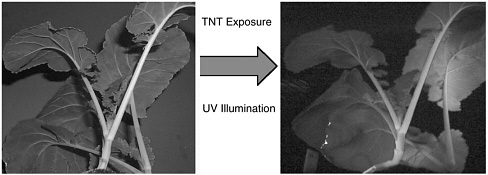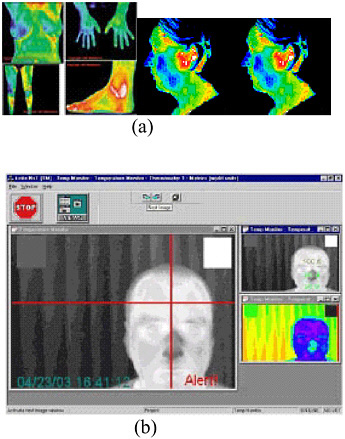6
Biological Markers
Biologically based systems for explosives detection are quite numerous. However, their efficacy for standoff monitoring, sensitivity, and robustness remains undefined. It is likely that many of these systems suffer similar fundamental limitations (comparative to instrumental analytical methods) in contacting a target analyte at a sufficiently high, localized concentration to produce a detection signal in a relative time frame suitable for standoff detection. Consequently, remote standoff detection of explosives using biological sensor technology or electronic noses to replace or improve upon the trained canine olfactory sense has been difficult to achieve.
Biological or biosensor approaches for explosives detection combine the specificity of molecular recognition of biomolecules with electronics for signal transduction and measurement. These biomolecules may be directly coupled to the analytical device or they may be part of a living cell or organism, which in turn is a component of the analytical system.
Antibodies have been applied in many difficult immunosensor formats, including fiber-optic evanescent and surface acoustic waves, flow injection,1 and surface plasmon resonance immunosensors, to provide direct recognition of an analyte. Textbook examples2 of this technology are
replete with design, application, and sensitivity considerations. In addition to antibodies, a variety of other proteins, ranging from receptors in olfactory neurons to G proteins and bacteriorhodopsin have been explored as potential bioaffinity biosensor elements. In general, these biosensor systems have implementation requirements (size, power, ruggedness) that are not dissimilar to a spectrophotometer, laser, gas chromatography (GC), or mass spectroscopy (MS) based systems. In other words, biosensor systems have instrumentation requirements that may limit their use for standoff detection in the field.
In many cases, modern molecular biology has provided the tools to isolate and modify the genes for individual receptors or signaling proteins to make new biosensor capability. A recent example used computational biology to analyze a binding protein and predict changes to an amino acid sequence that would create new proteins capable of specifically binding to an analyte such as trinitrotoluene (TNT).3 By directed mutagenesis, the DNA encoding the binding protein was synthesized and cloned into bacteria. The fluorescent properties of the protein changed on binding to TNT, providing a direct real-time measure of TNT binding. Furthermore, the binding protein could be linked to a second signal via a signal transduction mechanism to activate a transcriptional fusion in living cells to produce a whole-cell TNT biosensor system. Engineered bacterial strains have previously been developed that couple bioluminescent (lux) or fluorescent (green fluorescent protein [GFP]) reporter proteins to transcriptional activation by chemicals such as TNT, to create biosensor organisms that have been explored for use in explosives detection4 or coupled directly to microluminometer chip technology for whole-cell biosensing.5 Efforts have been made to identify genes that are induced or activated by explosives such as TNT for both mammalian6 and plant systems.7 This raises the potential of engineering animals or plants with lu-

FIGURE 6.1 Canola plant engineered with a GFP reporter fusion responsive to TNT exposure. Right panel indicative of positive plant response in passive sentinel monitoring. (N. Stewart, University of Tennessee)
minescence or fluorescence reporter genes for passive monitoring for explosives as conceptually suggested by Figure 6.1.
Although there is potential for biological sensor technology, the ability to implement this technology, particularly from a standoff perspective, has not yet been shown to be practical.
HUMAN EXPOSURE BIOMARKERS FOR ORTHOGONAL DETECTION OF EXPLOSIVES
Sources and Exposure
Exposure to explosives produces wide-ranging biological effects from the organ system to the subcelluar. The ability to produce such signatures is highly variable according to the classes of explosives and exposure history. The published literature to support these analyses is highly variable in source, availability, and information content. However, the National Library of Medicine TOXNET Hazardous Substances Database does an excellent job of summarizing this material.
Literature studies, exposure analysis, and toxicological properties have been conducted by the military (Wright Patterson Air Force Base, Soldiers Biological and Chemical Command, for example) and its government contactors (GeoCenters, for example), the Environmental Protection Agency, the National Institute for Occupational Safety and Health, and the Agency for Toxic Substances and Disease Registry (ATSDR) among others. These studies provide a source of information on exposure to explosives such as cyclotrimethylenetrinitramine (RDX) in cooking fuel,
TNT, dinitrotoluene (DNT), and picric acid as environmental contaminants and RDX in fireworks, as well as explosives themselves and explosion residuals. The ATSDR ToxFAQ database is a relatively comprehensive source for summary information on occurrence, exposure, and effects.
In general, explosives are readily bioavailable to human populations through the usual contact, inhalation, and ingestion sources from which they may be bioaccumulated, although not necessarily biomagnified. A recent report clearly demonstrates that many nitrated aromatic explosives are readily partitioned (1-2 hours) from contaminated soil to skin through dermal percutaneous absorption.8 Such uptake is correlated with solubility and vapor pressure and thus is similarly driven during direct topical exposure. Ultimately, the body burden of the parent explosive or metabolites, cellular and subcellular effects, and resulting analytical detection sensitivity are determined by the chronic or acute nature of the exposure history. Consequently, there would likely be significant biosignature differences between bomb makers and bomb carriers who should exhibit differing exposure histories.
Effects
Most explosives demonstrate multiple effects. For example, propylene glycol dinitrate (PGDN) reportedly produces effects as ambiguous as headaches and as specific as methemoglobinemia, with other effects ranging from transient central nervous system (CNS) effects to vascular collapse.9 Other explosives such as TNT have been identified as carcinogens. Many of the nitrated explosives are associated with headaches on exposure, which is due to the vascular dilating effect of nitrate, characteristic of therapeutic agents such as nitroglycerin. Metabolites, conjugates, and DNA adducts are frequently encountered for broad groups of explosives, and these may in themselves represent suitable signatures for detection and exposure analysis because they may pigment the skin or be excreted in urine.
Biological Signatures
Potential biological signatures exist across all levels but with indeterminate value for standoff detection purposes. Those explosives producing vascular effects typically associated with headaches are candidates for
biosignatures due to altered blood flow, localized temperature differentials and perhaps concomitant skin discoloration. ATSDR database information supports a conclusion that TNT and picric acid in addition to producing headaches, are also skin irritants and systemic colorants, producing yellow pigmentation (including hair) on prolonged exposure. TNT metabolites excreted in urine typically impart amber to red color to the urine. These pathologies along with the previously mentioned skin partitioning of explosives suggest the prospects for Fourier transform infrared (FTIR) skin spectrometric sensing.10
Nitrates, particularly dinitrobenzene (DNB), trinitrobenzene (TNB), and PGDN, typically produce methemoglobinemia at higher exposure concentrations. A common symptom of this potentially fatal syndrome is a blue cast to the skin due to NO3 competitive binding to hemoglobin.
Analogous to genotoxic environmental pollutants, explosives with mutagenic and/or DNA adducting properties can produce biomarkers of subcellular damage. Characteristically, these biomarkers are difficult to assess and analytical improvements are necessary. Furthermore discriminating other environmental insults, such as smoke, may make unambiguous results difficult to achieve.
A comprehensive analytical solution could include infrared (IR) imaging of the skin, particularly face and hands, for increased blood flow. IR thermographic technology is already used extensively in medicine and sports therapy. Such screening was utilized in the outbreak of severe acute respiratory syndrome (SARS). Figure 6.2 shows the general capabilities of thermographic imaging and a specific example of SARS thermal imaging. It should be noted that the use of thermographic technology in relatively open environments (as opposed to controlled situations such as customs at an airport) has not yet been extensively investigated, and technological and privacy issues will probably have to be addressed.11
Many hazardous chemical exposures result in contact dermatitis and rashes. These conditions, in addition to increased blood flow, would offer IR and other spectral patterns that could be analyzed in a standoff capability. The same holds true for situations in which methemoglobinemia alters apparent skin color or situations in which skin is dyed or pickled (picric acid). Hyperspectral image analysis such as that available to the Littoral Airborne Sensor-Hyperspectral (LASH, U.S. Navy) or passive so-
|
10 |
See, for example, work in this area by Professor Reinhardt Brunch, Department of Physics, University of Nevada, Reno; http://www.physics.unr.edu/faculty/bruch/Opticmain.htm. |
|
11 |
Pang, C.; Gu, D. L. Some problems about detecting the suspected cases of SARS according to the local skin temperatures on face. Space Med. Med. Eng. (Beijing) 2003, 16(3), 231-234. |

FIGURE 6.2 A generalized example of (a) the routine capability available for thermographic imaging, and (b) its use in screening for potential SARS cases.
nar in the case of heartbeat or pulse analysis may provide an existing path to an analytical solution for multispectrum analysis.
Although they would not constitute a standalone, independent measure of explosives, biological signatures could be relatively inexpensive (when implemented with other hyperspectral methods) to use as part of an integrated system of explosives detection. The analytical (spectroscopic) methods needed to implement this technology either presently exist or are in development for other applications. In addition, a large data base could be developed rapidly and could have broader applications such as drug transport screening.
The use of biological signatures could be expanded to direct detection of skin or surface absorbed explosives using laser-induced fluorescence. This could be applicable to both portal scenarios and large unsupervised crowds.
Potential Challenges
There are potential barriers to the use of biological signatures in standoff explosives detection that must be addressed. Hyperspectral imaging has inherent limitations. Confounding factors such as other pathological conditions and natural variations in temperature and skin color must be filtered out if this technology is to be effective. The volume of people and characteristics to be screened may lead to very large data processing and management requirements. Finally, this approach may be relatively insensitive to conditions of minimal or short-term exposure to explosives and thus miss individuals who are exposed to explosives only immediately prior to a bombing.
While thermographic imaging is well established, hyperspectral imaging is less developed for whole body analysis. Research would be required to determine if this approach can be implemented for real-time standoff analysis. A key question is whether hyperspectral images can be obtained that can discriminate between natural population variance, other pathological disease state conditions, and actual explosive exposure. If the use of hyperspectral imaging is determined to be useful for standoff explosives detection, it must be determined whether analytical tools such as LASH could be directly applicable for its implementation or whether new hyperspectral tools would be required.
Research would also be needed to evaluate the explosive’s exposure path and history with respect to sensitivity of detection. For example, does casual exposure of a bomber create a signature that can be discriminated, or does it take the chronic exposure of a bomb maker to create a sufficient signature? Can superficial skin-absorbed explosives, or explosives in hair, be excited (illuminated) to produce an explosive biosignature spectrum directly?
As noted earlier, biosignatures would best be utilized as an orthogonal technology in a systems approach to standoff explosives detection. To effectively integrate the use of biosignatures, research would be needed into how well imaging data bases correlate for behavioral imaging versus biosignature imaging, and whether meaningful orthogonal relationships exist. In like manner, a systems approach would require that an orthogonal relationship be established between biosignatures and other methods of direct explosives detection or imaging.
Recommendation: Research is needed on biological markers related to physiological changes in persons associated with bomb making and bomb delivery and based on the chemical composition of the explosive.







